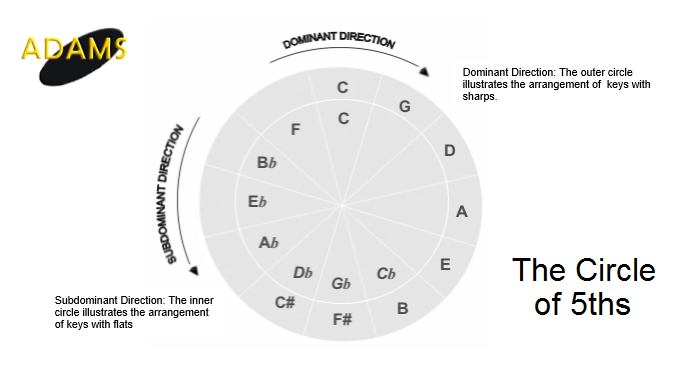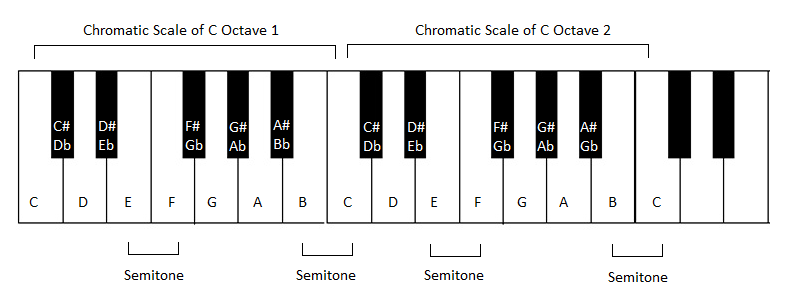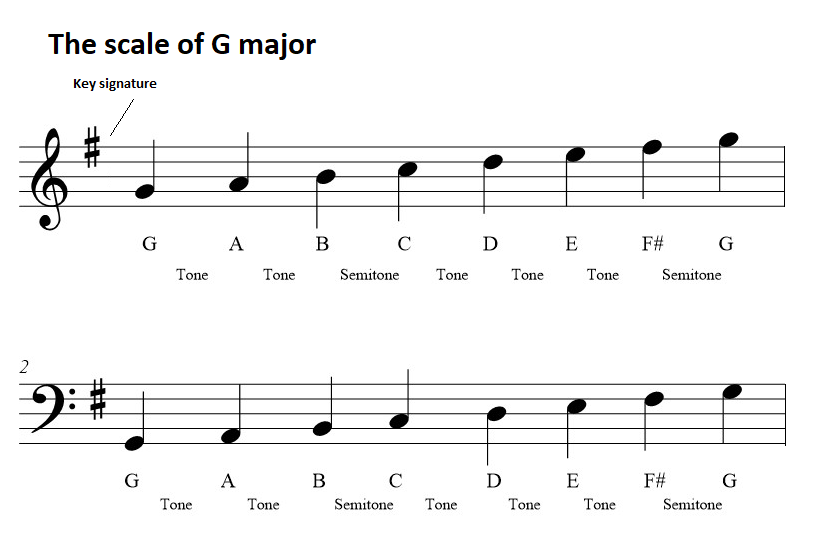
The Circle of Fifths
A detailed discussion - how to construct and use the Circle Of Fifths
Includes discussions and video tutorials
Includes discussions and video tutorials
Terms used in this discussion
Scale or key, tonal structure, tonic, Intervals, perfect fifth, perfect fourth, enharmonic, sharps, flats, relative minor, major and chromatic.
Print this page to pdf
For those who prefer to read offline, print this page as a PDF document and save it to your drive or the cloud.
Introduction to The Circle of Fifths
There
is nothing mysterious about the circle of fifths. Think of the Circle
of Fifths as a chart of major and minor scales arranged vertically. The
chart is subdivided into two sections, the upper section of the chart
tabulates scales that have sharps, in their key signatures. The
lower section of the chart tabulates scales that have flats in their key
signatures. Our discussion includes videos and textual content spanning
the following topics :
- The unit of measurement
- The enharmonic
- The chromatic scale
- The major scale and its unique tonal structure
- The intervals of a perfect 4th and 5th
THE UNIT OF MEASUREMENT IN MUSIC
The semitone and tone are the
terms used to describe the measurement of the interval between two
notes. For example, C to C# is a semitone, while the interval, C to D,
is a tone. C first moves to C# then moves over to the note D. C to C# is
the first semitone, while C# to D is the second semitone. Two
semitones, are equal to one tone, therefore, the interval C to D has a
measurement of two semitones or 1 tone. (semitone + semitone = tone).
Spend time on the piano. Mark off the tone and semitone intervals in other keys. While in our discussion we will refer to the tone and semitone only, there are many other terms to measure intervals that are way smaller than the semitone. An example is the microtone which is smaller than the semitone.

THE ENHARMONIC
Notice that each of the black keys
has two names, e.g. C# and Db, which is the first black note in the illustration
above. We call this the enharmonic equivalent and they sound the same.
Here are a few examples.
Here are a few examples.
C# is the enharmonic equivalent of
Db.
Db is the enharmonic equivalent of C#
Another example is,
D#, which is the enharmonic of Eb.
A white key may also have an enharmonic.
The note, A, is the enharmonic equivalent of B double flat.
The pitch B is the enharmonic of, A double sharp.
In some contexts, it is necessary to refer to the pitch, F, as E#, or, Fb, as E natural. Another example is B# which is the note, C natural, and Cb, which is the note B natural.
We will discuss other enharmonic equivalents within the context of the scale.
THE CHROMATIC SCALE
The tonal structure of major
and minor scales is best understood by learning the chromatic scale.
There are rules to follow when writing the chromatic scale. In our
example we are going to keep it simple at first. You can refer to a more
comprehensive account of the chromatic scale in our online tutorials.
An important feature of the chromatic scale is the fact that the distance between adjacent notes is always an interval of a minor second. The minor second interval on the piano will be played from a white key then moving to the adjacent black key. In other words, it has an interval of a semitone. Example, C to Db is a semitone interval.
Notes such as B to C, and E to F, are already semitone intervals and do not have a black key in between.
An important feature of the chromatic scale is the fact that the distance between adjacent notes is always an interval of a minor second. The minor second interval on the piano will be played from a white key then moving to the adjacent black key. In other words, it has an interval of a semitone. Example, C to Db is a semitone interval.
Notes such as B to C, and E to F, are already semitone intervals and do not have a black key in between.

SEMITONE INTERVALS
There are special instances where
two white notes on the piano, will form an interval of a semitone or
minor second. The two examples are E to F and B to C. You will also
note that the black key does not feature between E to F and B to C. As mentioned earlier, E# is enharmonic of F natural and Fb is the enharmonic of E natural.
B# is the enharmonic of C natural and Cb is the enharmonic of B natural.
B# is the enharmonic of C natural and Cb is the enharmonic of B natural.

The major scale
The major scale has five tones and two semitones. The intervals in all diatonic major scales are specifically arranged as follows: Tone, Tone, Semitone, Tone, Tone, Tone, Semitone. Take a look at the illustration below. Notice that the diatonic scale has only 7 unique notes and the the chromatic scale has 12 unique notes.

The C Major Scale
The semitones or half-steps in a major scale are always located between notes, three and four & seven and eight. This will always be the case with every major scale. In order to maintain the tonal structure of the major scale, some notes have to be raised using sharps and lowered, with the use of flats.
There are seven intervals in the C major scale which contribute to it's characteristic sound. They are arranged as follows:
Tone, tone, semitone, tone, tone, tone and semitone.
The semitones or half-steps in a major scale are always located between notes, three and four & seven and eight. This will always be the case with every major scale. In order to maintain the tonal structure of the major scale, some notes have to be raised using sharps and lowered, with the use of flats.
There are seven intervals in the C major scale which contribute to it's characteristic sound. They are arranged as follows:
Tone, tone, semitone, tone, tone, tone and semitone.
This arrangement of intervals is used for every major scale.
In the examples that follow you will see the same arrangement.
In the examples that follow you will see the same arrangement.
The scale of G Major
Although the notes are different, the tonal structure of the G major scale, remains the same as any other major scale.
Tone, tone, semitone, tone, tone, tone and semitone.
Although the notes are different, the tonal structure of the G major scale, remains the same as any other major scale.
Tone, tone, semitone, tone, tone, tone and semitone.
